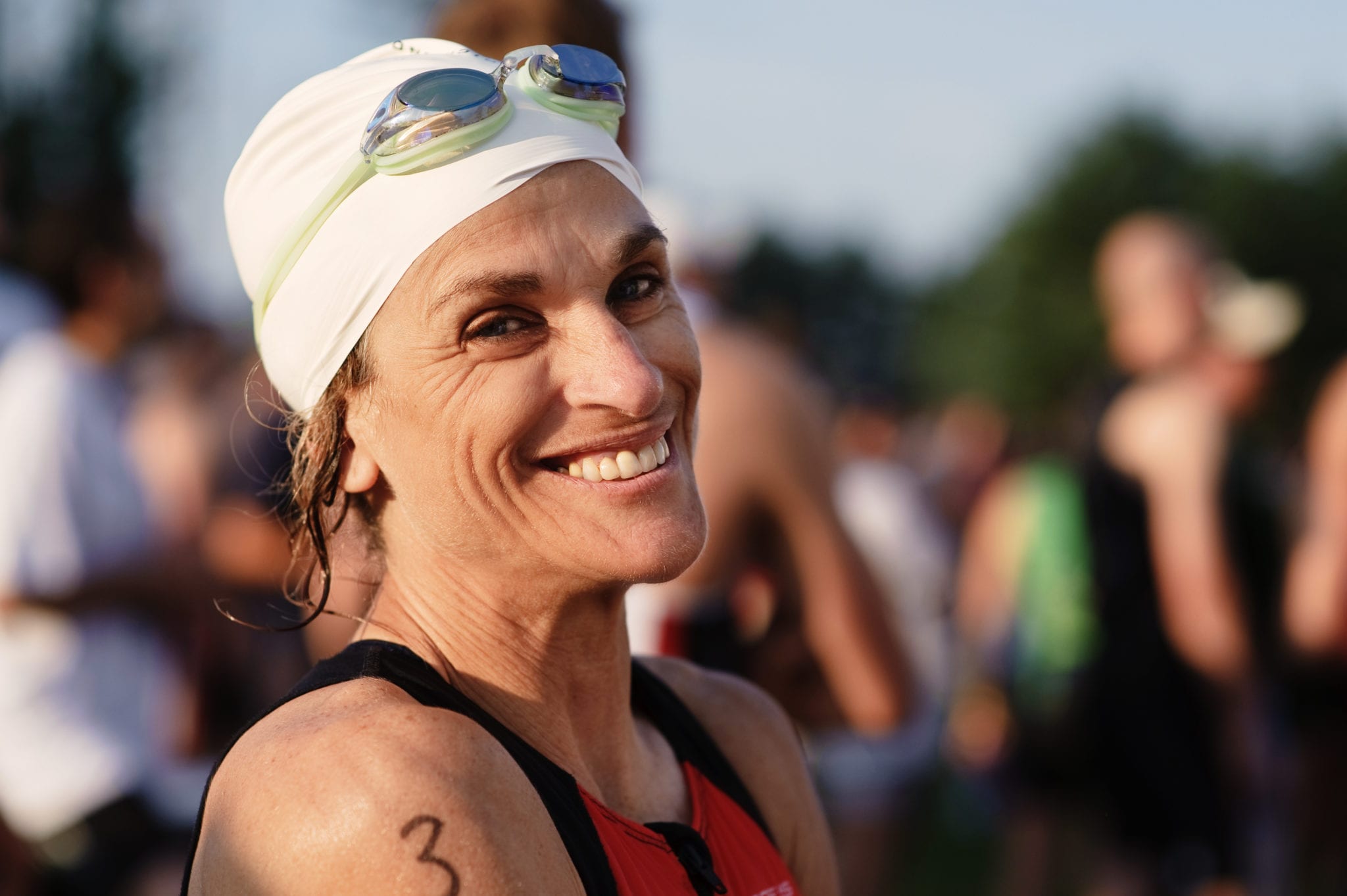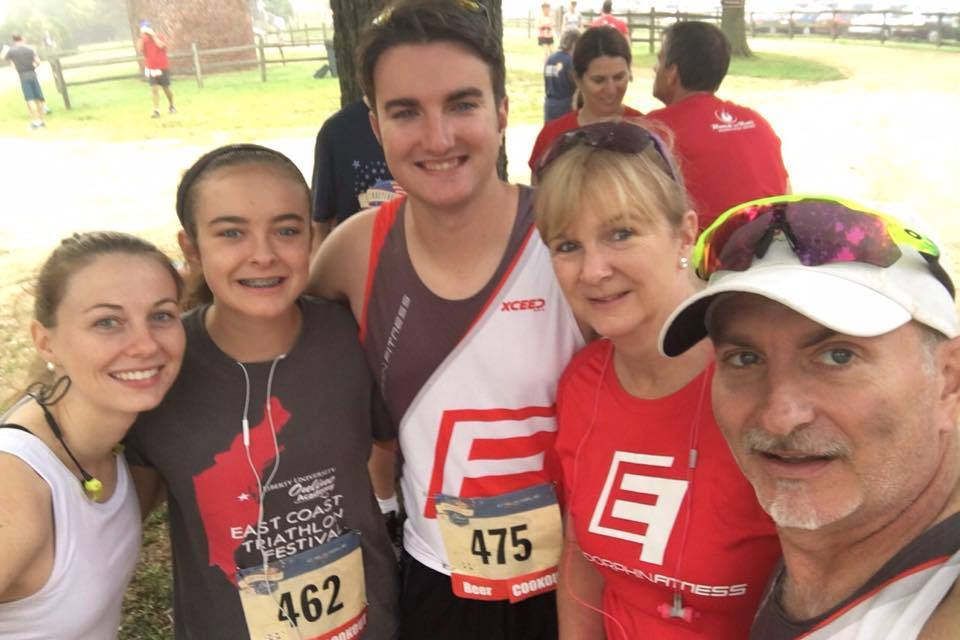There is something special about triathlon. It has this ability to change people. It has been known to pull some people from tough periods in their lives and show others that they can be more than they thought possible. Its community is infectious and inviting. Its races contagious. Cross a finish line and you will be hooked to the feeling it gives you. Experience the atmosphere and you will be begging for more.
I fell in love with triathlon twenty-four years ago and have enjoyed it consistently through many phases of my life. I have seen it evolve while the spirit has remained very much the same. It truly is special, and I am blessed to be able to share it with so many amazing people, many first timers.
Your first race though can be confusing so I wanted to write a guide to make your first race experience as amazing as possible. In this guide, I will give you the information you need to know before showing up for your first race. Enjoy and let me know if you have any questions at all by reaching out at the contact information at the bottom of this guide.
Race Arrival Time
For a first-timer, I always suggest arriving at the race about 2 hours before your race if you need to pick up your packet and plan to warm up which you should. As you get more experienced with the process, you can cut this to 1.5 hours before. Upon arrival, this is the order of things that should be done: pick up your race packet, pick up your chip, get body marked, set up transition, run warm up, bike warm up, stretch, swim warm up, stretch, pre-race meeting, and all the while focusing on pre-race nutrition.
The Race Packet
You can normally pick up your race packet the day before the race or the morning of the race. Check the race website / emails for details. You will need to bring your USA Triathlon Membership Card and a Photo ID, and the volunteers will give you a packet most likely including a race t-shirt, possibly some other race swag, and your numbers. The numbers are the important thing and what you should take out to use in the race. This includes the following:
- Run Number – This should be affixed to whatever you plan to wear on the run. We suggest a race belt which can be purchases at any triathlon shop (including EF) which can be put on as you run out of transition with the race number already on it. T-shirts ar difficult to get on when wet or sweaty so the race belt makes things easy.
- Bike Number – This will go on your bike. This is normally a big sticker that you will peel thebacking from and affix to either your top tube (the part of the bike you stand over when standing over your bike with your feet on the ground) or the seat post (this is preferred as long as you have enough room on it).
- Helmet Number – This is a small rectangle sticker which you should place on the front of your h This is only used to identify you for pictures but is a requirement from USAT.
- Swim Cap – If you are doing an open water swim, you will have a swim cap with a specific colorwhich signifies which wave you start in and must be worn during the race. If doing a pool swim, you may have been given a swim cap but it is not a requirement to wear one.
The USA Triathlon (USAT) Membership
You must have a USAT annual or one-day membership to race and bring this along with photo ID to packet pick up. This is how race directors cover your insurance in the race. You can purchase an annual membership at the USA Triathlon website. Adult memberships are $50 and youth (17 & under) memberships are $10 and last 365 days from the time of purchase. If you did not purchase an annual membership, you were most likely made to purchase a $15 USAT one day membership at registration which the race director will have record of on race day and therefore you don’t need to bring anything. There are no youth (17 & under) one day memberships as the cost of the annual membership is less expensive. If you are going to do more than two triathlons in the next 12 months, it makes financial sense to just purchase the year USAT membership.
The Timing Chip
Your timing chip will be given to you on race morning and is what will be used to time your race. This will most likely be given to you affixed to a strap that should be put on your left ankle immediately and left on until a volunteer takes it off after the cross the finish line. If wearing a wetsuit in the race, it is best to put the wetsuit leg over the timing strap so that taking off your wetsuit does not yank it off. If you do lose your timing chip during the race, the race director will charge you a fee most likely but this rarely happens. To prevent it though, you can wrap the ankle strap with electric tape to further secure it. Also, if you hear beeps when you cross timing mats before the race, don’t worry as this did not start your race early – it will be cleared before you start.
Body Marking
You will need to be body marked before the race begins. This means someone will write your race number on you with a marker so that your number is easily seen by race staff and officials throughout the race. There will be a set of volunteers holding markers stationed at the race – normally right outside of transition. They will most likely write your race number on both arms and both thighs. Additionally, they will write your age on your calf so that competitors know if you are in their age group. Be prepared to undress slightly at body marking to be marked.
The Transition Area
The key to transition is to keep things simple. Here is what you need: bike, helmet, sunglasses (optional but recommended), running shoes affixed with speed laces, and a race belt holding race number. Set up is simple! Hook the seat of your bike on the rack facing towards you (ideal is toward where you will exit transition to start your bike and as close as possible to this exit). Place your helmet with buckles open on handlebars / aerobars facing in such a way that when you put it on your head, it will not be backwards. Put your sunglasses in the helmet and open. If you have learned how to get into your shoes while riding, your shoes should already be clipped into the pedals and affixed parallel to the ground with rubber bands so that they do not flop around running out of transition. This is the fastest way but does take practice. If you prefer to put your cycling shoes on in transition or plan to bike in your running shoes, place them on the ground beside your front wheel. Your running shoes should be placed beside the front wheel regardless with the race belt holding the race number on top of your running shoes. Once set up, walk through transition a few times so you make sure you know how it flows and exactly where your spot is. To find your spot easily, locate landmarks nearby that you can use to locate your spot but do not make these someone else’s gear as that might not be there when you get to transition.
After the swim, you will run to your transition spot. Put on your helmet first. If your shoes are on the bike, grab your bike and run to the mount line. You MUST cross this line before getting on your bike or you will receive a 1 min penalty. If your shoes are on the ground, put them on and then run to the mount line. After the bike, you MUST get off the bike (put one foot down) before the dismount line or again you will receive a 1 minute penalty. Make sure you locate the mount and dismount lines before the race. Return your bike to your transition spot and rack it by the handlebars with the bike facing away from you (opposite of how you were racked in the first transition (T1).
Clothing
In most races, all you need is a tri suit which consist of a one or two piece uniform which you can swim, bike, and run in. If it is cold, you may choose to the following in this order based on level of cold and comfort: gloves, arm warmers, toe covers, jacket. Try to avoid the jacket if possible as it is hard to put on when wet.
Warm Up
It is important to get a warm up in before the race. If you are concerned about finishing the distance, some short dynamic exercises and a little swimming will suffice though more is preferential. If you are comfortable with the distance, I recommend a 5-10 minute run, 10-15 minute bike, and a 5-10 minute swim for a sprint or Olympic distance triathlon. Those who are used to a lot more volume would benefit from getting in a little longer warm up, especially on the bike. I also suggest including a little race pace intensity in the warm up: 4 x 100 yd strides on the run, 3 good solid minutes at race pace on the bike, and a 4 x 25 yds at race pace on the swim. Again, this should be customized to your goals and can be skipped if your goal is to simply complete the distance. If you are doing a full warm up, you should start this around 60-75 minutes before your race start. If it is a pool swim and you are not starting near the front, you will not be able to do a swim warm up or remove your bike after 15 minutes before the first swimmer starts so I recommend doing the bike, then swim, and leaving your run warm up for within 30 minutes of your start time. Follow each warm up segment with some light stretching.
The Swim
If it is a pool swim, you will be given a start time based on the swim time you entered at registration. Most races send participants off every 15 seconds with a larger break inputted periodically. Most pool swims follow a snake swim format whereas you will swim down and back in one lane and then push off the wall but at an angle so you go under the lane line and come up in the next lane (or just duck under it). Then, you repeat in each subsequent lane until you have completed the distance. If you need to pass someone, gently tap them on the feet and they should move over or stop at the wall for you.
Open water swims (lake, river, ocean) start in waves which are usually assigned by age groups. You will be called into the water with a wave of athletes about 3-5 minutes before your start time. Swim a little during this time and then position yourself at the start floating on your stomach waiting for the gun to go off. Other times, you will start on a beach on knee deep in the water and run into the water when the gun goes off. If this is the case, run until you get tripped by the water and then dive into the water and start swimming. If it is still shallow, you can use a technique called dolphin diving that takes some practice and can be looked up online or taught by your coach. You will want to make sure you study the swim course before the race and practice sighting before race day so you can navigate around the swim course.
The Bike
There are a few rules that you should know for the bike portion. I already discussed the mount and dismount line at the start and finish of the bike. Drafting and blocking are the other rules that typically catch people. In general, stay to the right of the road at all times so people can pass on your left. Also, you need to stay 3 bike lengths behind the cyclist in front of you. If you decide to pass though, you can enter the zone and pass them on the left before returning to the right side of the road in front of them BUT you only have 15 seconds to do so. I do not suggest timing your passes – just get on around them and don’t stay in a blocking position if you decide to pass. If you get passed, you MUST drop back 3 bike lengths BEFORE attempting to pass them again. Other than that, the bike is pretty simple – know the course, stay as low as possible (aero) on your bike to cheat the wind, and have a great time.
The Run
Make sure you take your race number / race belt on the run – you need this when you cross the finish line or you will receive a penalty. Other common rules are that you cannot use headphones on any segment of a triathlon. Additionally, you cannot receive assistance from others including having someone pace you (run with you). With that said, most beginner friendly triathlons look the other way for this rule. As you start the run, you should feel tired – RELAX, FOCUS ON YOUR FORM, & TAKE DEEP BREATHS. You will feel better as you get past the first half mile of the run. Enjoy it – you are almost done and the finish line will be a blast.
Nutrition
I have written extensive articles on race nutrition which is too much to cover here but I am happy to send you if you contact me. Make sure you eat and hydrate well the day before (mostly carbohydrates and water), get up early and have a good breakfast of carbohydrates race morning, and fuel smart during the race. Have a final small snack about 75 minutes before the start when you begin warm up and sip on sports drink the hour before the race. For a sprint triathlon, most nutrition is taking in before the race and all you need is a sports drink during the race. For longer races, you will want to fuel with some gels and possibly solids as well depending on the length of the race. If it is hot and/or you have a tendency to cramp, I suggest sodium supplementation before and during the race as well with a product such as s-caps.
Final Thoughts
You are about to embark on an amazing journey that has the potential to change your life. It is understandable that you might be nervous but don’t be too much – it is just a really fun day enjoying your fitness. Soak it up, cheer on the other participants, and have a blast. Congratulations!!







